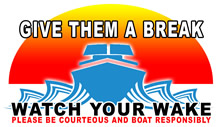Frequently Asked Questions
Currently, Paradise provides dockside service to the Lake of the Ozarks from Bagnell Dam to the 36 mile marker, and to the Gravois and Glaize arms, and to the 4 mile marker of the Big Niangua arm. Projects from any area of the lake can be brought to our modern 4,800 square foot shop located on the west side of Osage Beach.
Can I use my boat while you are working on our canvas job?
Paradise specializes in custom canvas work. This means that your project is built for your boat, and your boat must be available for patterning, fitting and installing. Throughout the process we’ll keep you informed of when we plan to be working on your boat, taking into consideration any periods of time that you’ll be using it. Rather than expect you to “play” around our work schedule, we work around your “play” schedule.
Although we work on projects in the order scheduled, there are some circumstances that can cause us to move around the schedule a bit. Much of the work takes place on the dock, and therefore weather can be a factor. If we’re building an enclosure for you and we’re having a few days of thunder storms, we’re likely to spend that time working on a boat that was brought to our shop, even if it was scheduled after you. Weather is our number one obstacle; the availability of materials is sometimes a factor as well.
What's the Best Way to Care for Cover Fabrics?
- Keep dirt, leaves, and other debris from accumulating on the fabric surface. Washing down with a garden hose on a bright, sunny day is recommended about once a month in warm weather. In colder months, use a soft bristle brush to sweep away debris. Do not scrub hard! Cover can be left on the boat for ease of cleaning.
- To remove dirt from either side of fabric, use a soft bristle brush and a mild soap solution (such as ivory) and warm water (no more than 100 deg F). DO NOT USE DETERGENTS! Do not use bleach. Rinse thoroughly with clear water.
- Always allow fabric to dry completely before rolling or storing. Be sure to clean and dry before storage. Mildew can grow during storage if moisture is present.
- DO NOT pressure wash or steam clean your cover fabric.
- If used for a boat cover, keep cover secure while trailering.
- Avoid dragging cover across rough surfaces, and tugging on cover during removal.
- Always keep cover taut to avoid water pooling and causing stretching. Avoid cinching cover too tightly, putting undue stress on seams and tie down loops.
- Repair accidental tears and punctures as soon as possible.
How Should I Care for My Marine Carpet or Woven Vinyl?
-
Occasionally vacuum and, if necessary, hose off carpet and allow to dry.
-
For stubborn stains, use a standard, high-quality carpet cleaner, taking care to remove all cleaner residue with water.
- NEVER fold your carpet or flooring; always store it dry and rolled face out.
What's the Best Way to Care for Vinyl?
-
Use a mild biodegradable boat soap or basic mild neutral soap such as Ivory or Lux mixed in lukewarm water. Use a soft brush or wool mitt to soap up your vinyl seats, trim and sun pad. Rinse thoroughly with clear water.
-
Thoroughly dry vinyl after washing and before covering your boat.
-
Use a vinyl cleaner and a soft brush on stubborn stains. Thoroughly wash vinyl after using cleaner to remove all residue.
-
Use separate rags and brushes for different vinyl colors to prevent color transfer, especially between colored and white vinyls.
-
Protect your vinyl from UV exposure. Apply a protectant containing UV-screening properties monthly.
Is There a Difference in Care for Clear Vinyl?
- Do not use abrasive cleaners
- Use a mild vinyl cleaner or basic mild neutral soap such as Ivory or Lux mixed in lukewarm water. Rinse thoroughly with clear water. DO NOT USE DETERGENTS.
- Avoid folding to prevent permanent creases; always roll for storage.
- Avoid storing on a rough surface such as unfinished fiberglass.
- Clean and dry thoroughly before storing, as debris pressed between layers for any length of time can cause permanent marring or impressions on the surface.
- Some minor impressions usually disappear when the sheet is relaxed and exposed to the heat of the sun. A deeper impression, however, may never disappear.
.
How long will my project take?
It’s common for us to have a full schedule for six to eight weeks, and a waiting list beyond that. Once we begin work on a project, you can expect the following timeframes:
Boat Covers – To make a boat cover, we must make three trips to your boat. We first measure the boat for a “blank,” which is a piece of material large enough to pull over your boat. Then we take the blank to your boat to fit it. It’s always impossible to predict how long this will take, because there are so many factors. Wind is our worst enemy, and even a slight breeze can make fitting difficult. We’ll fit covers in the rain if the boat is under cover, but we don’t work on docks during thunderstorms. During peak season, it’s very difficult to fit a boat located on the main channel unless we can get there early. The location of the boat is another factor – we work the lake in sections, as it is impossible to fit a cover on the 3 mile marker and at the 36 mile marker in the same day. Once the cover is fit, the rest is completed in the shop. The installation is also subject to weather conditions and location, but much less so than the fitting. Our goal is 10 – 14 days from the time that the cover has been fitted. If you are able to bring the boat to us, we can usually have it completed within 10-14 days from the scheduled start date.
Canvas Enclosures – Enclosures are very technical and generally require several trips to the boat for fitting. Time frames will vary depending upon how large the project is, but could take up to four weeks from the scheduled start date.
There is an official terminology in regard to marine accessories, but even that terminology may differ somewhat by region. The following is a list of components, along with pictures to help you identify your specific need.


|
BIMINI TOP (sometimes called Convertible Top) - an open-front canvas top, usually supported by a metal frame. Most Biminis can be collapsed when not in use, and stored in a bimini “boot.”
Boats that have a radar arch may have a Forward Bimini and an Aft Bimini, which extend from the arch and have a lesser metal support frame. |
 |
ENCLOSURE (also called Canvas) – a number of panels that all zip together and to a Bimini Top which, once connected, enclose an area of the boat. Enclosure is a generic term that encompasses many different configurations and combinations. |
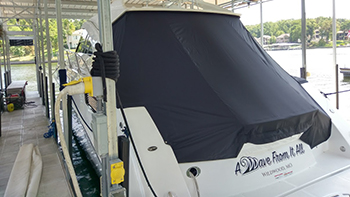 |
AFT CURTAIN – Canvas panels extend from the back edge of the Bimini Top, attached with zippers, to the top edge of the gunwale (pronounced gunnel). The bottom edge of the Aft Curtain is secured to the boat with snaps, common sense fasteners, stay-put fasteners, or a combination of fasteners. |
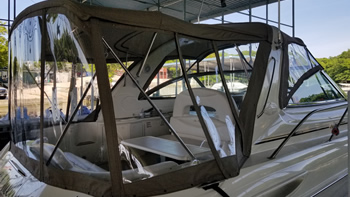 |
CAMPER BACK – This type of Enclosure requires an additional Bimini Top frame, from which Canvas panels drop nearly straight down from the Bimini Top to the gunwale, offering more head room. |
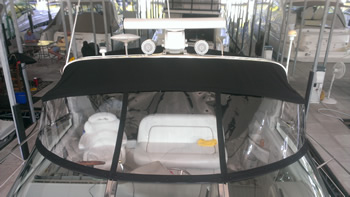 |
EISENGLASS (sometimes called Isinglass) – Clear vinyl from which windows and window panels are made. Window panels themselves are frequently referred to as Eisenglass. There are various grades of this material; higher grades provide more scratch resistance and better clarity. (pictured) |
| |
|
MOORING COVER – Mooring covers are made to cover the full length of a boat while the boat is moored, or not moving. It is not recommended that a boat be towed with a mooring cover, as the wind could tear it pretty quickly. There are several variations of mooring covers as follows: |
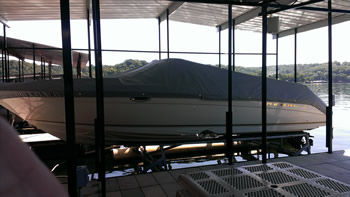 |
MOORING COVER TO THE RUB RAIL – the cover stops at and is secured under the rub rail by a drawstring. |
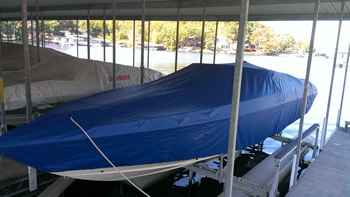
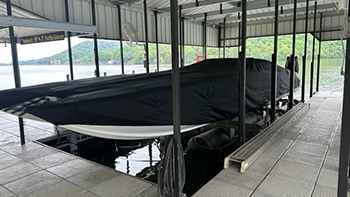
|
MOORING COVER TO THE CHINE LINE – the cover extends down the sides of the boat, to the angle on the hull where the side of the boat meets the bottom (chine line), and is secured with a drawstring. |
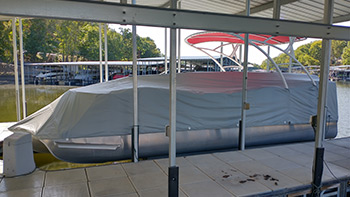

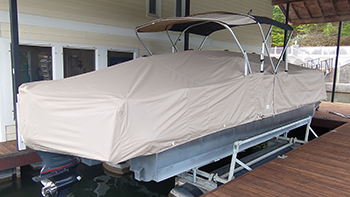
|
PONTOON DRAWSTRING COVER – Used on Pontoon boats as an alternative to a snap cover, these covers are secured by tightening a rope that is sewn in along the bottom edge of the cover. |
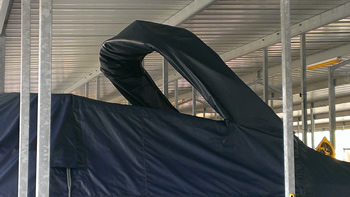 |
MOORING COVER WITH SEPARATE ARCH COVER– Any of the above mooring covers, with a separate, zip-on cover for the arch. |
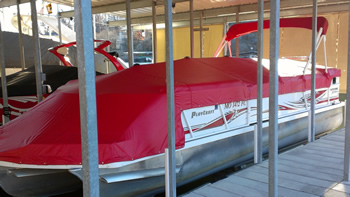 |
SNAP-ON MOORING COVER – Generally used on Pontoon and Deck boats, these covers are secured with snaps along the bottom edge of the cover. These covers require snap studs to be installed in the boat. |
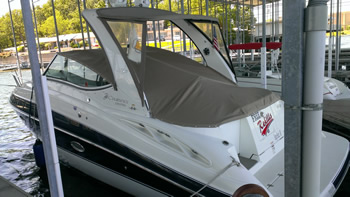
|
COCKPIT COVER – this covers only the cockpit area of a boat, and may stop at the top of the windshield, or cover the windshield. This cover is secured to the boat with snaps, and requires that snap studs be installed in the boat. |
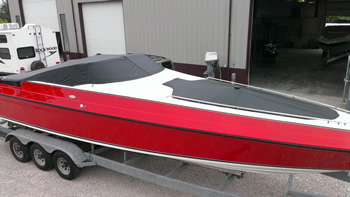
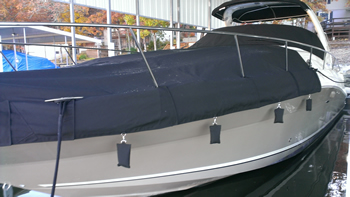
|
BOW COVER – covers the open bow area of a boat, and secures to the boat with snaps. This cover requires that snap studs be installed in the boat.
A bow cover may also be a fitted cover that lays on the fore deck of a cruiser, and secures with snaps or sand bags. |
|
|









